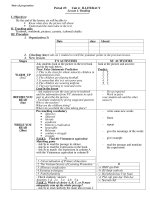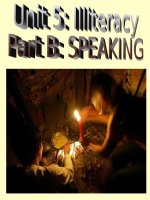unit 5- Illiteracy
Bạn đang xem bản rút gọn của tài liệu. Xem và tải ngay bản đầy đủ của tài liệu tại đây (100.54 KB, 20 trang )
Mai Thi Ngoc Uyen High school: B Phuly
Unit 5: Illiteracy
Lesson 1: Reading
I. Aims
By the end of the lesson , Ss will be able to
- Develop such reading micro- skills as scanning for specific ideas,
identifying main ideas, and identifying meaning in context
- Use the information they have read to discuss illiteracy issues
II. Materials
Textbook, handouts, pictures
III. Procedure
Time Steps Work
arrangement
7’
Warm- up
- T writes the word “ ILLITERACY” on the board.
- T divides the class into groups of 10 and introduces the
game: the groups should generate as many words
related to this word as possible in 5’
* Suggested words: illiteracy rate, literacy rate, ethic
minority groups, poverty, mountainous areas……..
Whole class,
group
works, Pair
works
8’
Before reading
- T lets Ss to work in pairs and try to make sense of the
picture on page 56.
- T calls on some Ss to describe the picture. If Ss have
difficulty talking about the picture. T may gives some
suggested questions. T may gives some suggested
questions:
+ What can you see in the picture?
+ Who is the teacher?
+What about the students?
+ Where do you think the class is place?
Whole class,
group
works, Pair
works
Mai Thi Ngoc Uyen High school: B Phuly
( Ss should give reason for their answers?)
“This is a class for ethnic minority children in
mountainous area. May be, the teacher is a border
soldier and works as a volunteer teacher because he is
wearing a soldier s uniform. The children are listening’
very attentively to their teacher. The class is very
simple”
- T gives Ss some new words
1. Universalisation of Primary Education: all children
who are at the age of going to school will have to be
learnt.-> pho cap giao duc
2. The Vietnam Society of leaning Promotion:
( explaining each word for Ss to guess)-> hoi khuyen
hoc Vietnam
3. Illiteracy Eradication: make children know to write
and read-> -xoa mu chu
4. campaign: movement , advertising
5. ethnic minority
6. the fight: struggle, scrap
7. farming techniques-> ky thuat canh tac
8. Family planning-> ke hoach hoa gia dinh
10’
While reading
Task 3
- T lets Ss to read each paragraph and find out the main
content in it
- T gives some suggested questions for each paragraph
* para 1
+ What was the rate of literacy in Vietnam in 2000
(94% of the population)
*para 2
Whole class,
Pair works
Mai Thi Ngoc Uyen High school: B Phuly
+ What campaign was started by the Vietnam Society of
Learning Promotion?
( The campaign for illiteracy eradication )
+ How many Ss participated in the campaign in 2000
and how many in 2001?
( 600 in 2000 and 800 in 2001)
+ What will happen if more and more ppl take part in
the struggle against illiteracy?
(illiteracy will soon be eradicated)
8’
Task 2
- T asks Ss to read carefully all sentences( or 4 titles ) in
Task 1 and sure that they can understand their meaning.
Then go back the passage
- Ss choose the most one individually and then work in
pair.
- T calls on some Ss to give their answers by reading
aloud or writing on the board
- T check their results with the whole class and gives
corrective feedback.
* Answer : D
A is too general; B and C are too specific
Whole class,
individual
works, Pair
works
12
After reading
Mai Thi Ngoc Uyen High school: B Phuly
Work in groups: Ask and answer the questions
- T gives Ss 2 questions in book to answer
- T may draw a net to give suggested answers
Whole
class ,
individual
works,
group works
3’
Wrapping- up
- T summarizes the main points of the lesson
- T gives homework for Ss
Whole class,
individual
works
Unit 5: Illiteracy
The ways of
literacy
eradication
Opening
school
Sending
volunteers
Buying
books for
Ss
Fund-
raising
Training local
people to be
teacher
Mai Thi Ngoc Uyen High school: B Phuly
Lesson 1: Speaking
I. Aims
By the end of the lesson , Ss will be able to
- Talk about schooling and literacy related problem.
- Suggest solution to these problems.
II. Materials
Textbook, handouts, pictures
III. Procedure
Time Steps Work
arrangement
5’
Warm-up
Matching game
- T divides the class into small groups of 3-4 students.
Then T distributes the following handouts for SS to do
the matching task in their own groups. Which group
finishes first and has appropriate answers * will be the
winner.
- T introduces the topic of the lesson: talk about school
problem.
Whole class
7’
While speaking
Task 1
- T introduces the task and gets Ss to do in pairs. T
should encourage Ss to guess the meanings of the new
words.
- T calls on a St to read out the answers.
- T checks with the class and gives corrective feedback.
T might also provide other similar expression.
Eg:
Enforce a law/ a regulation
Offer special tutoring lesson/ private lessons
Whole class,
individual
works, pair
works
Mai Thi Ngoc Uyen High school: B Phuly
Provide transportation to school/ school buses
Set up an English speaking club/ learning centers/
study groups
Suggested answer
1.b-g 2. a-e 3.d-f 4.c-h 5.i-j
13’
Task 2
- T introduces the task and call on one or two pairs of Ss
to read aloud the sample dialogue.
- T elicits the structures that are used for asking for
asking for and giving suggestions
Asking for opinion
What do you think we need to/ could/ should/ might
want too do?
What do you think about….?
What…s your opinion bout…?
What do you have in mind….?
Giving suggestions
Maybe we can…..
We might want to….
Probably we should…
We could….
- T puts Ss into groups of 3-4 and gets them to define
the problems of their own school and suggest as many
solutions as possible.
- T goes around to check and offer help
- T write these ideas on the board as Ss talk. Then - T
goes around to check and offer help
Whole class,
individual
works, pair
works
17’
Task 3
Mai Thi Ngoc Uyen High school: B Phuly
- T introduces the task : Ss are going to work together to
identify the problems of their own classroom and offer
solutions.
- T goes around and checks
- T calls on each group to report their ideas to the class
and elicits comments from the class.
- T goes around to check and offer help and final
comments
Suggested answer
1. Class size: an ideal class size is 10-15 Ss, so the
school should recruit more teachers and open
new classes.
2. Desks: buy larger desks or if they are new
classes, the current number of desks is
adequate.
3. Equipment: buy/hire facilities such as
computers and OHPs , upgrade the classroom
Whole class,
individual
works, pair
works
3’
Wrapping- up
- T summarizes the main points of the lesson
- T gives homework for Ss
Whole class
Unit 5: Illiteracy
Lesson 1: Listening
I. Aims
By the end of the lesson , Ss will be able to
Mai Thi Ngoc Uyen High school: B Phuly
- Develop extensive listening skills
- Use the information they have listened to for other communicative
tasks.
II. Materials
Textbook, cassette tapes, handouts
III. Procedure
Time Steps Work
arrangement
7’
Warm- up
- T prepares a small survey and copies it on the board.
T gets Ss to copy it down in their own notebooks. T
explains new words and how to do the task.
- T gets SS to move around and collect their friends’
opinion. They should interview at least 3 ppl.
Whole class
8’
Before listening
-T sets the scene: you are going to listen about the
results of a school survey carried out in Perth, Western
Australia. The school asked its students what makes
an effective school.
* Pre- teaching vocabulary
Maturity(n): su truong thanh
Academic(a0 : co tinh hoc thuat
Performance(n) su thuc hien
- T helps Ss to pronounce the word in their book
correctly. T may want to play the tape or model first
and then ask Ss to repeat after the tape after him or her
in chorus and individually.
- T present or elicits the meaning of these words from
the class.
Whole class,
individual
works, pair
works
While listening









